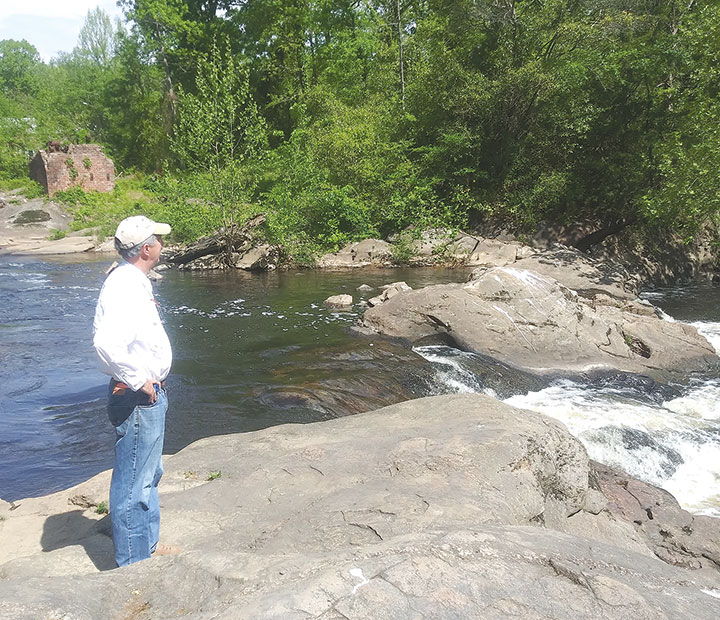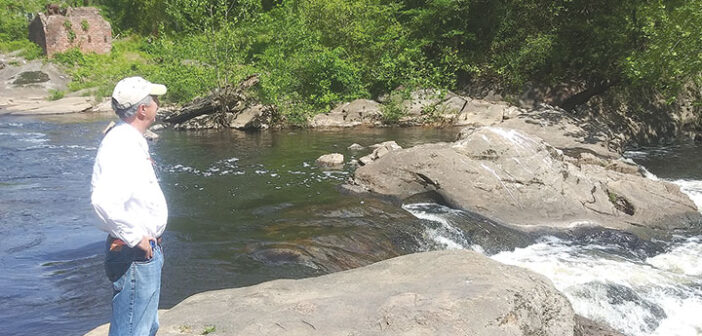
Lyle Browning stands next to the falls. The remains of a pump house is on left.
Falling Creek Ironworks Park likely would not exist if not for Bryan Walker, and the recently deceased 87-year-old will be honored at a May 4 ceremony at the park.
Lyle Browning — who serves as a volunteer archeologist for the nonprofit Falling Creek Ironworks Foundation — said he first got involved with the ironworks in the late 1980s or early 1990s when Walker organized a meeting about it. “He nudged people to do something and was instrumental in getting the county to buy it,” Browning said.
Today, the park mainly consists of a small area next to Jefferson Davis Highway that includes one of the historic Moore’s Lake cottages and a gated trail that can be used to access the south side of the creek and view its two waterfalls.
The county began acquiring land for the park in 1994 and added land in 1996, 2000, 2004, 2013 and 2016.
Two years ago, the park had a dedication ceremony to unveil numerous improvements, including a parking area, paved trails, interpretive signs and overlooks, according to Brian Truzzie, historic sites supervisor with the Chesterfield Parks and Recreation Department.
A long-term plan includes adding a walking bridge across the creek so visitors can view the falls when looking east.
Browning explained that Falling Creek Falls is the only place between Richmond and the Atlantic Ocean that has a head of water of at least 10 feet. This was essential to provide water power for an iron furnace, he said.
Saturday’s event marks the 400th anniversary of the ironworks, which was built from 1619-1622. It took two attempts, but English workers built an iron blast furnace there during that time. However, coordinated Indian raids throughout the region destroyed many settlements, including the furnace, on March 22, 1622.
Between 1750 and 1781, the site became an iron forge, started by Archibald Cary, a wealthy industrial entrepreneur. It was part of the manufacturing base during the Revolutionary War. Both industries were ended by wartime events, a press release states.
An industrial archeologist by trade, Browning said that iron ore was brought to the area from a limonite mine about 2 miles away. The ironworks used oyster shells for a fluxing agent, and charcoal was procured from the wooded land nearby. “It’s as if Mother Nature put it all together here for our use,” he said.
Today, visitors can see the remnant of a pump house and steel wall that served as a dam for a short-lived whiskey distillery that dates to the 1920s, he said.
The ceremony honoring Walker will start at 11 a.m. Also at that time, a sign will be dedicated for a small stone-and-brick cottage that was originally at Moore’s Lake, farther south on Jefferson Davis Highway.
Browning will offer 45-minute tours of the site at noon, 1, 2 and 3 p.m.
The celebration – which runs from 10 a.m. to 4 p.m. – also will include costumed interpreters, period musical performances, the Fort Lee 392nd Army Band, and demonstrations from the Wolf Creek Cherokee Tribe of Virginia, militia muskets, blacksmithing, candle making, tin pressing and pottery. Crafters and specialty food vendors will be on hand, and children can play period games and other activities.
The park is located at 6407 Jefferson Davis Highway. Admission and parking are free. Parking for the event will be at Bensley Recreation Center, 2900 Drewrys Bluff Road. Shuttles will transport visitors to and from the park.
For more information, call (804) 751-4946 or visit fallingcreekironworks.org.


